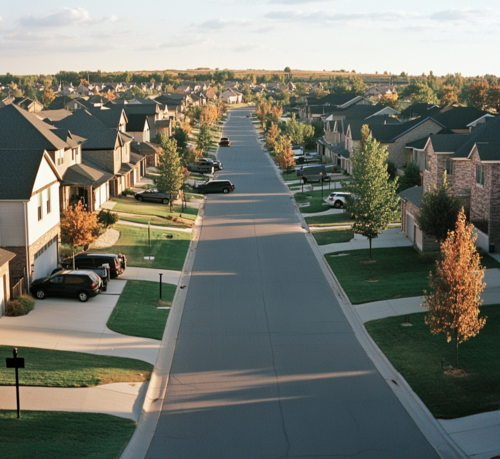Soil Quality and Garden Success
Introduction
The foundation of a thriving garden and stunning landscape lies beneath the surface—in the soil. Healthy, nutrient-rich soil is the cornerstone of gardening success, as everything flourishing above ground owes its vitality to the unseen processes underground. By nurturing your soil, you create an environment where plants can truly thrive.
The Importance of Soil Health
Healthy soil is essential for vibrant gardens and landscapes. It provides plants with the nutrients they need, regulates water retention, and fosters beneficial microbial activity. Taking care of your soil not only ensures lush growth but also improves the overall ecosystem in your garden.
Topsoil: The Lifeblood of Your Garden

A Hand Holding Healthy, Fertile Soil for Gardening
Topsoil , the uppermost layer of soil, is rich in organic matter and vital nutrients. This layer is where most plant roots reside and where crucial biological activity occurs.
What is Topsoil Made o f?
Topsoil comprises both organic and inorganic components:
- Organic Matter: Derived from decomposed plants, insects, worms, and other living organisms, organic matter enriches the soil and fosters microbial activity.
- Inorganic Materials: Sand, silt, clay, and broken-down rock provide structure and support to the soil.
Why Microbes Matter
Beneficial bacteria and fungi in topsoil play a critical role in:
- Breaking down organic matter into usable nutrients.
- Retaining moisture in the root zone.
- Enhancing soil aeration and structure.
Pro Tip:
Mix compost and organic mulch into your soil to maintain a thriving microbial community. These additions enrich the soil, regulate temperature, and retain moisture for optimal plant health.
Macro- and Micronutrients: Fuel for Plants
Plants require a balanced mix of nutrients to grow robustly. These nutrients are categorized as macronutrients and micronutrients.
Macronutrients: The “Big Three”
- Nitrogen (N): Promotes lush, green foliage.
- Phosphorus (P): Supports strong root systems and flower production.
- Potassium (K): Boosts plant resilience and overall health.
Micronutrients: The “Small but Mighty”
- Iron (Fe): Essential for chlorophyll production and photosynthesis.
- Manganese (Mn): Helps with enzyme activation and nitrogen utilization.
- Zinc (Zn): Aids in growth regulation and enzyme systems.
- Copper (Cu): Important for reproductive growth and photosynthesis.
- Boron (B): Vital for cell wall formation and flower and fruit development.
- Molybdenum (Mo): Helps plants use nitrogen effectively.
- Chlorine (Cl): Supports osmosis and ionic balance within the plant.
Where Did All the Topsoil Go?

A Modern Housing Development Highlighting Topsoil Challenges
In many modern housing developments, true topsoil has become a rarity. During construction, developers often remove or compact topsoil, replacing it with low-quality fill dirt. This soil is frequently:
- Poor in nutrients
- Heavy in clay, leading to drainage issues
- Compacted, restricting root growth
The Solution: Soil Rehabilitation
To restore soil quality, homeowners should consider professional soil testing and amendment. Adding compost, organic fertilizers, and aerating compacted areas can rejuvenate depleted soil and prepare it for planting.
Soil Preparation: The Key to Success

A Home Gardener Enhancing Soil Health with Fresh Compost
Proper soil preparation is vital for the long-term health of your garden. While sod can grow on poorly prepared soil with enough irrigation and fertilization, trees and shrubs require well-prepared soil to establish strong root systems.
Steps for Effective Soil Preparation:
1. Conduct a Soil Test:
- Take core samples from different areas of your garden.
- Send them to a lab for analysis to determine pH levels, nutrient content, and composition
2. Amend Your Soil:
- Add organic matter to improve nutrient content.
- Adjust pH levels to suit the plants you intend to grow.
3. Consider Drainage:
- Incorporate sand or perlite for better drainage in clay-heavy soils.
- Use raised beds for plants sensitive to waterlogging.
Expert Tip:
Landscapers often say, “Plant a nickel plant in a dollar hole.” This means investing in soil preparation rather than expensive plants ensures long-term success.
Unlock Your Garden’s Potential
At Arborist Now , we specialize in soil quality analysis and garden revitalization. Let us help you create the vibrant garden you’ve always dreamed of. From soil testing to expert recommendations, we’ll set your landscape up for success.
Contact Us Today!
Call Arborist Now to schedule your soil analysis and kickstart your garden’s transformation. Healthy soil means a flourishing garden—start your journey with us!
Originally published on May 3, 2020.


